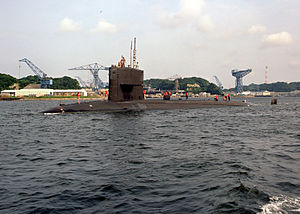
USS Drum (SSN-677) entering port on 11 August 1984.
A Victor III submarine similar to the K-324.
When the first ultra-quiet soviet nuclear-powered hunter/killer attack submarine, code-named Victor I by NATO, rolled down the ramp at the Admiralty yard in Leningrad in 1968, the U.S. Navy lifted a concerned eyebrow. Sixteen of the Victors splashed into the sea through 1975. By 1978, Seven Victor II submarines were added to the Soviet fleet, each carrying sixteen Stallion cruise missiles that could scream through the air at Mach 1.5 and destroy targets seventy-five miles away. Crews quickly manned battle stations whenever a Victor II was detected anywhere near a U.S. warship. For NATO forces, however, finding a Victor II was not that hard. Soviet engineers were skilled in weaponry but not in the art of stealth.
During the early years of the Cold War, the Soviet Union knew that its boats were noisy as hell. Built to keep up with fast U.S. warships, they had a distinct acoustic disadvantage. U.S. sonar operators often joked that Ivan’s subs “whined so loud, they sounded like cats in heat.” When the Soviets discovered through their spy network that American subs could easily track Victor IIs, they halted production to design the Victor III. To overcome excessive noise issues, the Soviets reverted to a tried-and-true tactic: they cheated.
During the late seventies and into the early eighties, the Soviet Union secretly contracted with Toshiba and Kongsberg—Japanese and Norwegian technology companies, respectively—for 140 Kongsberg computers, advanced software, and sophisticated propeller-milling equipment designed to quiet their noisy props. In direct violation of international trade agreements, the two companies, almost overnight, allowed the Soviet Union to produce quiet submarines. In 1979, they did just that with the introduction of the Victor III, which swung the Cold War pendulum back in their favor. For U.S. submariners, hunting Ivan just got a lot tougher, and the statement Commander Kinnaird R. McKee made in 1968 when he served as the CO of the USS Dace (SSN-607) all but came true.
In short, McKee opined that “eventually, U.S. and Soviet submarine capabilities will converge…. It will be blind man’s bluff with other submarines…because at some point, nobody will be able to find a submarine with anything.”
Thanks to Toshiba and Kongsberg, Victor IIIs sported ultra-quiet tandem four-bladed propellers and special sound-reducing shock absorbers to increase stealth. This class of hunter/killer attack submarine also came with something else entirely new. Mounted atop the rudder at the aft of the Victor III, a strange tear-shaped pod stretched nearly thirty feet from end to end, with a diameter of eight feet near the front of the pod. From a distance, the odd pod resembled an elongated egg with a sharp taper near the tail. By 1980, the U.S. Navy remained clueless as to what this mysterious pod could be. Obtaining close-up photos of a Victor III odd pod, so the NSA could determine its purpose, became a top priority for U.S. fast-attack submarines.
#
USS Drum, Sturgeon class attack submarine, collides with K-324, a Victor III–class nuclear submarine sitting on the surface in Peter the Great Bay.
The nuclear submarine USS George Washington collided with the Japanese freighter Nissho Maru on April 9, 1981, 110 miles southwest of Sasebo, Japan.
President Ronald Reagan now had two submarine accidents on his hands. Prime Minister Zenko Suzuki blasted him for taking more than a day to notify Japanese authorities about the Nissho Maru’s demise, and the fact that a U.S. P3 Orion aircraft circling overhead made no attempt to rescue the survivors. On April 11, President Reagan expressed regret over the accident and offered compensation to the victims while assuring the Japanese that radioactive contamination need not be a concern.
The Soviets threw their own spears. They insisted that a U.S. submarine had collided with K-324, a Victor III–class nuclear submarine sitting on the surface in Peter the Great Bay. K-324 sustained severe damage, and some of her crew were hurt in the accident. The United States denied the presence of any American submarines in the area at the time.
Part of the Northern Fleet and stationed out of Saint Petersburg, K-324 had come off the ramp at the Admiralty yard in 1979. She became the seventh vessel of the Komsomolsk line. Two years after the incident, thanks to the photos taken in 1981 by the USS Drum and other submarines, the United States identified the odd pod on the Victor III’s rudder as a housing for a towed sonar array. Proof came later that year when, on October 31, 1983, the USS McCloy (FF-1038) and K-324 were ensnarled in each other’s towed arrays some 280 miles west of Bermuda. K-324 was monitoring U.S. ballistic missile submarine movements, hoping to find one of our “boomer” SSBN submarines to shadow. The incident severely damaged K-324’s propeller. A tug towed her to Cienfuegos, Cuba, for repairs. Two years later, in 1985, the Soviets decommissioned K-324, and her crew never knew who hit them that day in April 1981.